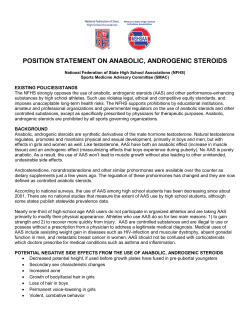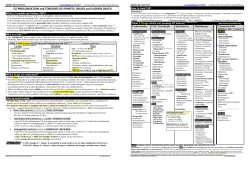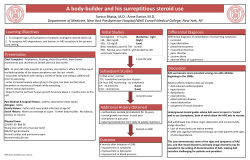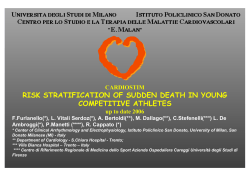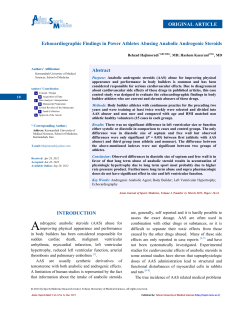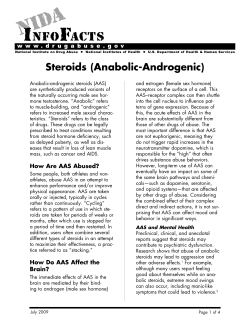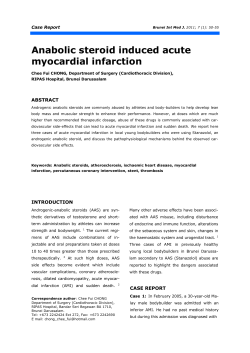
711
Srp Arh Celok Lek. 2012 Nov-Dec;140(11-12):711-716 ОРИГИНАЛНИ РАД / ORIGINAL ARTICLE DOI: 10.2298/SARH1212711D 711 UDC: 796.011.5:615.357.035 ; 616.12-073:796.071.2 Short QT Interval is Unreliable Marker of Anabolic Androgenic Steroid Abuse in Competitive Athletes Vitomir Djordjević1, Ivan Stanković2,3, Alja Vlahović Stipac2,3, Biljana Putniković2,3, Aleksandar N. Nešković2,3 Health Center “Dr. Ristić”, Belgrade, Serbia; School of Medicine, University of Belgrade, Belgrade, Serbia; 3 Department of Cardiology, Clinical Hospital Centre Zemun, Belgrade, Serbia 1 2 SUMMARy Introduction Previous animal and human studies provided the evidence that testosterone may affect ventricular repolarization by shortening of the QT interval. Synthetic derivatives of testosterone, modified to enhance its anabolic properties, are occasionally abused by some competitive athletes. Objective We assessed whether the QT interval duration could discriminate androgenic anabolic steroids (AAS)-using strength athletes (SA) from drug-free endurance athletes (EA), by comparing 25 formulas for QT interval correction. Methods We recruited 22 elite male athletes involved in long-term strength or endurance training and 20 sedentary controls. All elite SA reported AAS abuse, whereas EA and controls were AAS-free. Results AAS-using SA had markedly shorter QT-interval than AAS-free EA (348±42.3 vs. 400±34.2 ms; p<0.001). Also, drug-free EA had a significantly longer QT-interval than sedentary persons (400±34.2 vs. 358±18.9 ms; p<0.01). In contrast, no significant difference in the QT-interval duration was observed between AAS users and control group (348±42.3 vs. 358±18.9 ms; p=0.394). After the QT interval was adjusted for heart rate (HR) according to 25 different formulas, only the Ashman equation yielded considerable differences among the groups that were in line with those observed before correction. Conclusion Inconsistent results obtained by different correction formulas along with inability to discriminate QT (QTc) interval duration between AAS-misusing athletes and control group do not support the use of QT (QTc) interval for anti-doping purposes. keywords: short QT interval; anabolic androgenic steroids; doping INTRODUCTION Anabolic androgenic steroids (AAS) are syn thetic derivatives of testosterone, modified to enhance its anabolic properties. Data from several animal and human studies provided the evidence that testosterone may also affect ventricular repolarization by shortening of the QT [14]. In spite of being prohibited by the World AntiDoping Agency, AAS are frequently used by competitive athletes to improve performan ce. It has been recently suggested that the QT interval duration may be a marker of AAS abu se in strength athletes, as abusers were shown to have significantly shorter QT intervals than drugfree strength athletes and sedentary con trols [5]. OBjECTIvE It is uncertain whether this observation depen ds on athletic discipline (strength versus endu rance training) or formulas used for the heart rate correction of the QT interval. The objec tive of this study was to assess whether the QT interval duration can discriminate AASusing strength athletes from drugfree endurance at hletes when multiple formulas for QT interval correction are used. METHODS Twentytwo elite male athletes, aged 2240 ye ars, were recruited from the national weight lifting, bodybuilding, wrestling, water polo, swimming and running teams, and were divi ded into two groups. The first group consisted of 10 strength at hletes (5 weightlifters and 5 bodybuilders) who reported both past and current selfadministra tion of AAS. All subjects used the combinati on of both oral and injectable substances for at least 2 years (up to 5 years) prior to study enrollment. The second group included 12 endurance athletes (6 longdistance runners, 4 water polo players and 2 swimmers) who denied both pre sent and past AAS use. They were all negati ve on several doping tests during and out of competition. The control group was formed of 20 sedentary healthy men, aged 2040 years (physicians from the Clinical Hospital Centre Zemun), who denied AAS abuse. None of the subjects in either group had history of cardiovascular or any other system Correspondence to: Vitomir DJORDJEVIĆ Dom zdravlja „Dr Ristić“ Narodnih heroja 38 11070 Novi Beograd Srbija witomir@hotmail.com 712 Djordjević V. еt al. Short QT Interval is Unreliable Marker of Anabolic Androgenic Steroid Abuse in Competitive Athletes disorder and were not taking any medications. All su bjects gave written informed consent and were guaranteed anonymity. Anthropometric and blood pressure measurements Body mass and height were measured using a balance beam scale and a height gauge, respectively, whereas body surface area was calculated using the Mosteller formula [6]. Blood pressure measurements were done in a sitting position according to RivaRocci, using a cuff adjusted to upper arm circumference (mean value of two measu rements on both arms, 10 minutes apart, was recorded). Echocardiography All examinations were done in supine left decubitus posi tion by the same experienced cardiologist using Hewlett– Packard Sonos 2500 machine (Andover, MA, USA), with a 2.5 MHz transducer. Echocardiograms consisted of two dimensional, Mmode and Doppler flow measurements from standard parasternal and apical positions. All measu rements were made according to the American Society of Echocardiography recommendations [7]. Left ventricular mass was calculated according to the Devereux formula and indexed for body surface area [8]. Electrocardiography and QT interval measurement Twelvelead electrocardiogram (ECG) was recorded by the Shiller AG AT2 plus system (Baar, Switzerland) at a paper speed of 50 mm/s, prior to blood pressure measurement and echocardiographic examination. The PR interval was measured from the beginning of the P wave to the be ginning of the Q or R wave. The QT intervals were measured manually from lead II, from the beginning of Q wave to the end of the T wave. The end of the T wave was defined as its return to the TP baseline. If the end of the T wave could not be identified in lead II, lead V3 or V5 was used instead. All measurements were done by the same investigator who was blinded to the group and identity of the subjects. To test the interobser ver variability, all QT intervals were repeatedly measured by a second blinded investigator. The paired sample ttest did not find a statistically significant difference between the two series of measurements (p=0.81). Only measure ments from the first investigator were reported and used for calculations. Heart rate correction of the QT interval (QTc) was done using 28 different formulas listed in Table 1 [932]. As the QTc interval ≤380 ms was reported to have 83% sensitivity and 88% specificity in prediction of AAS abu sing power athletes [5], the QT intervals corrected by the Bazett formula were compared to this cutoff value with respect to AAS use. doi: 10.2298/SARH1212711D Table 1. Heart rate correction formulas Formula (Author’s name) Adams Ashman Bazett Boudolas Boudolas – logarithmic Framingham Fridericia Hodges Hodges – exponential Karjalainen Kawataki Klingfield Kovacs Larsen and Skulason Lecocq 1 Lecocq 2 Ljung Mayeda Rautaharju Rickards Sarma/Hodges Schlamowitz Simonson Simonson – logarithmic Todt Van de Water Yoshinaga Wohlfart Reference number Equation QTc = QT + 0.1536 × (1.0 - RR) QTc = 0.380 × log(10 × (RR + 0.07)) QTc = QT/RR0.5 QTc = QT + 2.0 / 1000 × (HR - 60) 9 10 11 12 QTc = QT/RR0.398 12 QTc = QT + 0.154 × (1.0 - RR) QTc = QT/RR0.333 QTc = QT + 1.75 / 1000 × (HR - 60) 13 14 15 QTc = QT/RR0.38 16 QTc = QT + correction from published table QTc = QT/RR0.25 QTc = QT + 1.32 / 1000 × (HR - 60) QTc = QT - 0.12 + 0.12/RR 18 19 20 QTc = QT + 0.125 × (1.0 - RR) 21 QTc = QT - 0.017 - 0.676 × e QTc = QT - 0.017 - 0.704 × e-3.7RR QTc = QT + 0.2 × (1.0 - RR) QTc = QT/RR0.604 QTc = QT - 0.656 / (1 + 0.01 × HR) + 0.41 QTc = QT + 1.87 / 1000 × (HR - 60) QTc = QT - 0.018 - 0.708 × e-3.7RR QTc = QT + 0.205 × (1.0 - RR) QTc = QT + 0.14 × (1.0 - RR) 22 22 23 24 25 26 15 27 28 QTc = QT/RR0.32 28 QTc = QT + 0.1 × (1.0 - RR) QTc = QT + 0.087 × (1.0 - RR) QTc = QT/RR0.31 QTc = QT + 1.23 /1000 × (HR - 60) 29 30 31 32 -3.7RR 17 QTc – heart rate corrected QT interval in seconds; QT – uncorrected QT interval in seconds; RR – RR interval in seconds; HR – heart rate in beats per minute Statistical analysis Data are expressed as mean±standard deviation. Com parisons among groups were performed using one way analysis of variance (ANOVA). When group differences were found (p<0.05), post hoc analyses were performed by the least significant difference (LSD) test. A p value of <0.05 was considered significant. RESULTS Baseline characteristics Subject characteristics are summarized in Table 2. The at hletes and controls were comparable for age and systolic blood pressure; strength athletes had a significantly higher diastolic blood pressure as compared to endurance athletes and controls. Endurance athletes were significantly taller than subjects from other two groups, while strength athle tes were heavier than sedentary men. As expected, there 713 Srp Arh Celok Lek. 2012 Nov-Dec;140(11-12):711-716 Table 2. Baseline characteristics Parameter Age (years) Height (cm) Body mass (kg) BSA (m2) BMI (kg/m2) Systolic BP (mm Hg) Diastolic BP (mm Hg) A (n=10) B (n=12) C (n=20) 27.3±6.4 181±4.6 100.4±18.6 2.2±0.23 30.4±4.8 133±23 88±14.2 27.3±3.9 190±10.8 89.6±14.9 2.2±0.24 24.6±2.3 118±12 71±8.4 29.8±4.1 182±9.1 78.6±8.3 1.9±0.12 25.2±2.2 124±11 74±5.6 p value ANOVA 0.242 <0.001 <0.001 0.001 <0.001 0.085 <0.001 A vs. B 1.000 0.016 0.194 1.000 <0.001 0.084 <0.001 A vs. C 0.551 0.273 <0.001 0.001 <0.001 0.390 0.001 B vs. C 0.453 <0.001 0.082 0.011 1.000 0.924 1.000 n – number of patients; A – anabolic androgenic steroids (AAS) using strength athletes; B – AAS-free endurance athletes; C – AAS-free sedentary controls; BSA – body surface area; BMI – body mass index; BP – blood pressure Table 3. Echocardiographic data Parameter IVS (mm) PW (mm) LV EDD (mm) LV mass (kg) LV mass index (kg/m2) p value A (n=10) B (n=12) C (n=20) 10.7±2.1 10.3±2.1 52.9±5.8 217.4±47.3 97.3±20 10.7±1.7 9.9±1.4 57.1±3.9 244.8±58.9 113.5±28.2 9.8±0.7 8.6±1.1 48.3±2.8 156.4±19.6 80.1±11.9 ANOVA 0.151 0.006 <0.001 <0.001 <0.001 A vs. B 1.000 1.000 0.032 0.381 0.381 A vs. C 0.294 0.012 0.006 0.001 0.001 B vs. C 0.366 0.043 <0.001 <0.001 <0.001 IVS – interventricular septum; PW – posterior wall; LV – left ventricle; EDD – end-diastolic diameter were significant differences in body surface area and body mass index among groups. Standard echocardiographic parameters Standard echocardiographic parameters are detailed in Table 3. All subjects had preserved left ventricular (LV) systolic function (LV ejection fraction >0.55). The LV internal enddiastolic diameter was greater in endurance athletes as compared to strength athletes and controls. LV mass, also when indexed for BSA, was greater in athletes than controls, with no significant difference between the strength and endurance athletes. Electrocardiographic data Resting heart rate (HR) was significantly lower, while the PR interval was longer in the endurance athletes when compared to the strength athletes and sedentary controls (Table 4). Nine athletes (41%) had HR of less than 60/min, whereas two of them (9%) exhibited first degree atrioven tricular (AV) block. AAS using strength athletes had the shortest and AAS free endurance athletes the longest QT intervals. Howe ver, no significant difference in QT interval duration was observed between the AAS users and sedentary controls (Table 4). The reported differences among the groups were also observed when the QT interval was adjusted for he art rate using Ashman and one of the Lococq’s formulas. However, if any other correction formula was applied, no significant differences in the QTc interval among the gro ups were detected (Table 4). As the consequence of calculation by different formulas was that the duration of the QTc interval varied as much as 59 ms (350±33.2 vs. 409±47.8 ms for the Ashman and Mayeda equation, respectively). Furthermore, when the QT interval was corrected according to the Bazett formula, 50% of AAS abusers and 34% of AASfree subjects had QTc≤380 ms, resulting in 50% sensitivity and 66% specificity of suggested cutpoint. DISCUSSION We compared the QT interval among strength athletes who abused ASS, drugfree endurance athletes and se dentary controls. Our data revealed that the AAS using athletes had the shortest QT intervals, but no significant difference in the QT interval was observed between stren gth athletes taking AAS and sedentary men. Importantly, these observations were highly affected by formulas used for QT correction. QT interval and AAS abuse The rationale for association between a shorter QT inter val and androgen abuse is derived from animal and human studies suggesting that sex hormones may be responsible for differences in cardiac repolarization. It has been obser ved that testosterone shortens ventricular repolarization while estrogens have weak opposite or no effect [14]. After puberty, men have significantly shorter QTc in tervals than women, which is most striking genderrelated electrocardiographic feature. In contrast, no genderrela ted differences in QT interval duration at birth and before puberty can be observed [1]. Additionally, it has been shown that virilized women have markedly shorter QT intervals than agematched healthy controls, with the duration of repolarization being inversely www.srp-arh.rs 714 Djordjević V. еt al. Short QT Interval is Unreliable Marker of Anabolic Androgenic Steroid Abuse in Competitive Athletes Table 4. Electrocardiographic data Parameter HR (beats/min) PR interval (ms) QT interval (ms)* QTc - Adams QTc – Ashman* QTc - Bazett QTc - Boudolas QTc - Boudolas (log) QTc - Framingham QTc - Fridericia QTc - Hodges QTc - Hodges (exp) QTc - Karjalainen QTc - Kawataki QTc - Klingfield QTc - Kovacs QTc - Larsen & Skulason QTc - Lecocq1* QTc - Lecocq 2 QTc - Ljung QTc - Mayeda QTc - Rautaharju 1 QTc - Rickards QTc -Sarma/Hodges QTc - Schlamowitz QTc - Simonson QTc – Simonson (log) QTc - Todt QTc - Van de Water QTc - Yoshinaga QTc - Wohlfart A (n=10) B (n=12) C (n=20) 77.5±15.9 151±22.3 348±42.3 382±33.2 350±33.1 398±42.1 383±32.1 387±38.4 382±33.2 378±37.2 378±31.8 385±37.9 379±30.5 371±36.8 371±32.6 388±35.5 375±33.4 335±40.9 380±34.2 392±34.3 409±47.8 385±30.7 380±31.9 379±34.2 393±34.5 379±33.2 378±37.1 370±34.3 367±34.9 377±36.9 369±32.9 55.8±7.8 174±18.1 400±34.2 383±21.3 406±26.2 381±19.8 392±24.8 385±19.2 383±21.3 387±37.2 393±25.6 385±19.3 390±22.8 390±22.2 395±27.4 391±22.4 386±21.3 385±33.4 397±26.9 378±24.1 377±22.3 388±23.1 393±25.2 396±26.9 377±24.5 384±21.1 388±20.2 389±22.5 390±23.4 388±20.5 395±27.8 75.3±10.8 154±22.1 358±18.8 386±25.2 359±23.2 400±36.4 388±27.1 391±30.6 386±25.2 385±27.3 384±25.2 389±29.6 389±24.7 378±23.8 378±22.4 389±29.5 381±23.1 345±18.7 382±25.3 395±29.1 409±43.1 392±27.9 386±26.1 381±25.3 396±29.6 384±24.1 384±26.7 376±21.5 374±20.8 383±26.3 376±21.9 ANOVA <0.001 0.017 <0.001 0.878 <0.001 0.312 0.728 0.855 0.876 0.820 0.432 0.908 0.526 0.244 0.090 0.971 0.611 <0.001 0.283 0.259 0.074 0.811 0.577 0.291 0.211 0.843 0.741 0.194 0.085 0.670 0.060 p value A vs. B A vs. C <0.001 0.616 0.001 0.734 <0.001 0.394 0.913 0.645 <0.001 0.429 0.264 0.875 0.429 0.605 0.890 0.729 0.922 0.647 0.541 0.635 0.205 0.559 0.951 0.702 0.315 0.311 0.107 0.531 0.039 0.491 0.845 0.995 0.324 0.564 <0.001 0.419 0.169 0.842 0.257 0.785 0.067 0.994 0.792 0.531 0.299 0.581 0.175 0.846 0.212 0.800 0.601 0.605 0.443 0.618 0.083 0.504 0.036 0.478 0.374 0.604 0.026 0.479 B vs. C <0.001 0.011 <0.001 0.719 <0.001 0.142 0.703 0.596 0.710 0.830 0.381 0.739 0.917 0.214 0.085 0.824 0.583 0.001 0.161 0.109 0.033 0.721 0.524 0.166 0.087 0.948 0.709 0.178 0.082 0.620 0.709 * p<0.05 HR – heart rate; QTc – corrected QT interval in milliseconds associated with testosterone levels [3]. Finally, therape utic testosterone administration in hypogonadic men is associated with a significant QTc interval shortening with negative linear correlation between QTc and testosterone concentration [2]. Therefore, selfadministration of AAS may be expected to shorten the QT (QTc) interval in male athletes when compared to those who do not misuse AAS, irrespectively of athletic discipline or activity level. This concept was partially supported by Bigi et al. [5] who reported a shorter QTc interval in AAStaking str ength athletes when compared to both AASfree athletes and controls. This observation was endorsed by the recent recommendations for ECG interpretation in athletes [33], suggesting that the QTc interval ≤380 ms (using Bazzet correction formula) may predict AAS abuse with high sen sitivity and specificity. However, when this cutoff point was applied to subjects enrolled in our study, sensitivity and specificity were markedly below those reported in the original paper. It is uncertain whether this cutoff value is applicable to endurance athletes as the study from which it originates [5] included only strength athletes. Furthermore, it has been also noticed by Stolt et al. [34] that strength athletes who abuse AAS exhibit shorter QT doi: 10.2298/SARH1212711D (QTc) interval that drugfree endurance athletes, while QTc interval duration could not discriminate AAS abusers and sedentary controls. On the other hand, a markedly longer QTc interval in drug free endurance athletes can be at least partially explained by increased vagal tone in these subjects. Indeed, endurance athletes, apart from be ing AAS free, had significantly lower resting heart rate and longer PR interval than strength athletes and sedentary men. Both lower heart rate and PR interval prolongation are well documented and prevalent phenomena which are believed to reflect augmented vagal tone in athletes invol ved in long term endurance training. The role of QT interval correction Among the numerous factors that contribute to the QT interval duration, heart rate plays a major role. Therefore, it is the standard practice to use a correction formula to adjust the QT interval for heart rate. Over 30 formulas have been devised for this purpose but all of them are li kely to introduce an error in assessing the QTc interval [35]. This error can exceed 60 ms for the Bazett’s square 715 Srp Arh Celok Lek. 2012 Nov-Dec;140(11-12):711-716 root formula which, despite several important limitations, gained the widespread acceptance [36]. For instance, it overcorrects the QT interval at high heart rates and un dercorrects at low heart rates [13]. Consequently, its use may be associated with inaccurate QT interval correction in elite athletes, as the majority of highly trained enduran ce athletes (up to 80%) exhibit bradycardia [33]. The Bazett formula was used by Bigi et al. [5], while Stolt at al. [34] used the Karlajanan nomogram method for the QT interval correction. Both studies used only one formula for the QT correction, although the imprecision in the QTc calculation could outweigh the differences among the studied groups. In order to overcome any bias, we used 28 formulas for the QT interval correction, including tho se most frequently used (Bazett, Fridericia, Framingham, Karlajanan and Hodges). We found that only Ashman and Lecocq equations yielded results that were in line with tho se observed before the correction, whereas no significant differences in the QTc interval among the groups were detected if any other correction formula was used. Study limitations Our study has two important limitations. First, history of AAS use was selfreported by athletes and controls inclu ded in the study, as we did not perform plasma or urine assessment for drug levels. Although results should be in terpreted cautiously, we believe that the observed differen ces in subjects’ clinical characteristic support the accuracy of their statements regarding AAS use. Both resting heart rate and diastolic blood pressure, in crease of which had been previously related to AAS abuse [37], were the highest in the AASusing athletes, with no difference between endurance athletes and sedentary con trols who denied AAS selfadministration. Secondly, as we aimed to include only elite athletes, we recruited a small number of subjects, which might have produced type II error (falsenegative results). However, a significant difference in QT interval duration was obser ved among the groups before its correction for the heart rate, suggesting that the sample size was sufficient for planned investigation. Nevertheless, further studies with adequate power are warranted. CONCLUSION Inconsistent results obtained by different QT interval correction formulas, as well as inability to discriminate QT (QTc) interval duration between AAS taking athletes and sedentary men prevented us from drawing conclusi ons relevant for antidoping control. It appears that the QT (QTc) interval cannot be used for antidoping purposes. REFERENCES 1. James AF, Choisy SC, Hancox JC. Recent advances in understanding sex differences in cardiac repolarization. Prog Biophys Mol Biol. 2007; 94:265-319. 2. Charbit B, Christin-Maitre S, Demolis JL, Soustre E, Young J, FunckBrentano C. Effects of testosterone on ventricular repolarization in hypogonadic men. Am J Cardiol. 2009; 103:887-90. 3. Vrtovec B, Meden-Vrtovec H, Jensterle M, Radovancevic B. Testosterone-related shortening of QTC interval in women with polycystic ovary syndrome. J Endocrinol Invest. 2008; 31:653-5. 4. Liu XK, Katchman A, Whitfield BH, Wan G, Janowski EM, Woosley RL, et al. In vivo androgen treatment shortens the QT interval and increases the densities of inward and delayed rectifier potassium currents in orchiectomized male rabbits. Cardiovasc Res. 2003; 57:28-36. 5. Bigi MA, Aslani A, Aslani A. Short QT interval: a novel predictor of androgen abuse in strength trained athletes. Ann Noninvasive Electrocardiol. 2009; 14:35-9. 6. Mosteller RD. Simplified calculation of body-surface area. N Engl J Med. 1987; 317:1098. 7. Lang RM, Bierig M, Devereux RB, Flachskampf FA, Foster E, Pellikka PA, et al. Recommendations for chamber quantification: a report from the American Society of Echocardiography’s Guidelines and Standards Committee and the Chamber Quantification Writing Group, developed in conjunction with the European Association of Echocardiography, a branch of the European Society of Cardiology. J Am Soc Echocardiogr. 2005;18:1440-63. 8. Devereux RB. Detection of left ventricular hypertrophy by M-mode echocardiography: anatomic validation, standardization, and comparison to other methods. Hypertension. 1987; 9 Suppl II:19-26. 9. Adams W. The normal duration of the electrocardiographic ventricular complex. J Clin Invest. 1936; 15:335. 10. Ashman R. The normal duration of the Q-T interval. Am Heart J. 1942; 28:522-34. 11. Bazett JC. An analysis of time relations of electrocardiograms. Heart. 1920; 7:353-67. 12. Boudoulas H, Geleris P, Lewis RP, Rittgers SE. Linear relationship between electrical systole, mechanical systole, and heart rate. Chest. 1981; 80:613-7. 13. Sagie A, Larson MG, Goldberg RJ, Bengtson JR, Levy D. An improved method for adjusting the QT interval for heart rate (the Framingham study). Am J Cardiol. 1992; 70:797-801. 14. Fridericia LS. Die Systolendauer im Elekrokardiogramm bei normalen Menschen und bei Herzkranken. Acta Med Scand. 1920; 53:469-86. 15. Hodges M. Rate correction of the QT interval. Cardiac Electrophysiol Rev. 1997; 1:360-3. 16. Hodges M, Salerno D, Erlien D. Bazett’s QT correction reviewed: Evidence that a linear QT correction for heart rate is better. J Am Coll Cardiol. 1983; 1:694. 17. Karjalainen J, Viitasalo M, Mänttäri M, Manninen V. Relation between QT intervals and heart rates from 40 to 120 beats/min in rest electrocardiograms of men and a simple method to adjust QT interval values. J Am Coll Cardiol. 1994; 23:1547-53. 18. Kawataki M, Kashima T, Toda H, Tanaka H. Relation between QT interval and heart rate. Applications and limitations of Bazett’s Formula. J Electrocardiol. 1984; 17:371-5. 19. Klingfield P, Lax KG, Okin PM. QTc behavior during treadmill exercise as a function of the underlying QT-heart rate relationship. J Electrocardiol. 1995; 28(Suppl.):206-10. 20. Kovacs SJ Jr. The duration of the QT interval as a function of heart rate: A derivation based on physical principles and a comparison to measured values. Am Heart J. 1985; 110:872-8. 21. Larsen K, Skulason Th. Det normale Elektrocardiogram. I. Analyse af Ekstremitetsafledningerne hos 100 sunde Mennesker I Alderen fra 30 til 50 Aar. Nord Med. 1941; 9:350-8. 22. Lecocq B, Lecocq V, Jaillon P. Physiologic relation between cardiac cycle and QT duration in healthy volunteers. Am J Cardiol. 1989; 63:481-6. 23. Ljung O. A simple formula for clinical interpretation of the QT interval data. Acta Med Scand. 1949; 134:79. 24. Mayeda I. On time relation between systolic duration of heart and pulse rate. Acta Scholae Med Univ Imp Kioto. 1934; 17:53. 25. Rautaharju PM, Warren JW, Calhoun HP. Estimation of QT prolongation. A persistent, avoidable error in computer electrocardiography. J Electrocardiol. 1990; 23(Suppl):111-7. www.srp-arh.rs 716 Djordjević V. еt al. Short QT Interval is Unreliable Marker of Anabolic Androgenic Steroid Abuse in Competitive Athletes 26. Rickards AF, Norman J. Relation between QT interval and heart rate: New design of physiologically adaptive cardiac pacemaker. Br Heart J. 1981; 45:56-61. 27. Schlamowitz I. An analysis of the time relationships within the cardiac cycle in electrocardiograms of normal men. I. The duration of the Q-T interval and its relationship to the cycle length (R-R interval). Am Heart J. 1946; 31:329. 28. Simonson E, Cady LD, Woodbury M. The normal Q-T interval. Am Heart J. 1962; 63:747-53. 29. Todt H, Krumpl G, Krejcy K, Raberger G. Mode of QT correction for heart rate: Implications for the detection of inhomogeneous repolarization after myocardial infarction. Am Heart J. 1992; 124:602-9. 30. Van de Water A, Verheyen J, Xhonneux R, Reneman RS. An improved method to correct the QT interval of the electrocardiogram for changes in heart rate. J Pharmacol Methods. 1989; 22:207-17. 31. Yoshinaga M, Tomari T, Aihoshi S, Kawashita T, Nishi J, Tanaka Y, et al. Exponential correction of QT interval to minimize the effect of the heart rate in children. Jpn Circ J. 1993; 57:102-8. 32. Wohlfart B, Pahlm O. Normal values for QT interval in ECG during ramp exercise on bicycle. Clin Physiol. 1994; 14:371-7. 33. Corrado D, Pelliccia A, Heidbuchel H, Sharma S, Link M, Basso C, et al. Recommendations for interpretation of 12-lead electrocardiogram in the athlete. Eur Heart J. 2010; 31:243-59. 34. Stolt A, Karila T, Viitasalo M, Mantysaari M, Kujala UM, Karjalainen J. QT interval and QT dispersion in endurance athletes and in power athletes using large doses of anabolic steroids. Am J Cardiol. 1994; 84:364-6. 35. Malik K. The Imprecision in heart rate correction may lead to artificial observations of drug induced QT interval changes. PACE. 2002; 25:209-16. 36. King A, Marc Bailie M, Olivier NB. Magnitude of error introduced by application of heart rate correction formulas to the canine QT interval. Ann Noninvasive Electrocardiol. 2006; 11(4):289-98. 37. Urhausen A, Albers T, Kindermann W. Are the cardiac effects of anabolic steroid abuse in strength athletes reversible? Heart. 2004; 90(5):496-501. Кратак QT интервал није поуздан показатељ злоупотребе андрогених анаболичких стероида код професионалних спортиста Витомир Ђорђевић1, Иван Станковић2,3, Аља Влаховић Стипац2,3, Биљана Путниковић2,3, Александар Н. Нешковић2,3 Дом здравља „Др Ристић“, Београд, Србија; Медицински факултет, Универзитет у Београду, Београд, Србија; 3 Одељење кардиологије, Клиничко-болнички центар „Земун“, Београд, Србија 1 2 КРАТАК САДРЖАЈ Увод Раније студије на животињама и људима показале су да тестостерон може да утиче на реполаризацију комора тако што скраћује QT интервал. Синтетске деривате тестостерона, модификоване тако да појачају његова анаболичка дејства, повремено злоупотребљавају професионални спортисти. Циљ рада Истраживали смо да ли се трајање QT интервала разликује између спортиста који се баве спортовима снаге и користе андрогене анаболичке стероиде (ААС) и спортиста који се баве спортовима издржљивости и не користе ААС, упоређујући 25 формула за корекцију QT интервала. Методе рада У истраживање је укључено 22 елитних спортиста мушког пола који су неколико година професионално тренирали спортове снаге или издржљивости и 20 здравих особа (контролна група) седентерног начина живота. Сви спортисти који су се бавили спортовима снаге користили су ААС, док су спортисти који су се бавили спортовима издржљивости и испитаници контролне групе негирали употребу ААС. Примљен • Received: 01/09/2011 doi: 10.2298/SARH1212711D Резултати Код спортиста који су користили ААС забележен је значајно краћи QT интервал него код спортиста који нису користили ААС (348±42,3 према 400±34,2 ms; p<0,001). Такође, код спортиста који нису користили ААС утврђен је значајно дужи QT интервал него код особа седентерног начина живота (400±34,2 према 358±18,9 ms; p<0,01). Није било статистички значајне разлике у трајању QT интервала између корисника ААС и испитаника контролне групе (p=0,394). Након корекције QT интервала применом 25 различитих формула, само су применом Ашманове једначине добијене значајне разлике између група које су примећене и пре корекције. Закључак Неконзистентни резултати добијени применом различитих формула и немогућност утврђивања значајне разлике између спортиста који су користили ААС и испитаника контролне групе не препоручују примену QT (QTc) интервала у антидопинг сврхе. Кључне речи: кратак QT интервал; андрогени анаболички стероиди; допинг Прихваћен • Accepted: 15/12/2011
© Copyright 2025

